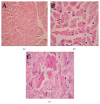Cardioprotective Activity of Pongamia pinnata in Streptozotocin-Nicotinamide Induced Diabetic Rats
- PMID: 25954749
- PMCID: PMC4411441
- DOI: 10.1155/2015/403291
Cardioprotective Activity of Pongamia pinnata in Streptozotocin-Nicotinamide Induced Diabetic Rats
Abstract
Pongamia pinnata (L.) Pierre has been used in traditional medicine for the treatment for diabetes and metabolic disorder. The aim of this study was to investigate the effect of petroleum ether extract of the stem bark of P. pinnata (known as PPSB-PEE) on cardiomyopathy in diabetic rats. Diabetes was induced in overnight fasted Sprague-Dawley rats by using injection of streptozotocin (55 mg/kg, i.p.). Nicotinamide (100 mg/kg, i.p.) was administered 20 min before administration of streptozotocin. Rats were divided into group I: nondiabetic, group II: diabetic control (tween 80, 2%; 10 mL/kg, p.o.) as vehicle, and group III: PPSB-PEE (100 mg/kg, p.o.). The blood glucose level, ECG, hemodynamic parameters, cardiotoxic and antioxidant biomarkers, and histology of heart were carried out after 4 months after STZ with nicotinamide injection. PPSB-PEE treatment improved the electrocardiographic, hemodynamic changes; LV contractile function; biological markers; oxidative stress parameters; and histological changes in STZ induced diabetic rats. PPSB-PEE (100 mg/kg, p.o.) decreased blood glucose level, improved electrocardiographic parameters (QRS, QT, and QTc intervals) and hemodynamic parameters (SBP, DBP, EDP, max dP/dt, contractility index, and heart rate), controlled levels of cardiac biomarkers (CK-MB, LDH, and AST), and improved oxidative stress (SOD, MDA, and GSH) in diabetic rats. PPSB-PEE is a promising remedy against cardiomyopathy in diabetic rats.
Figures



References
MeSH terms
Substances
LinkOut - more resources
Full Text Sources
Other Literature Sources
Medical
Research Materials
Miscellaneous

